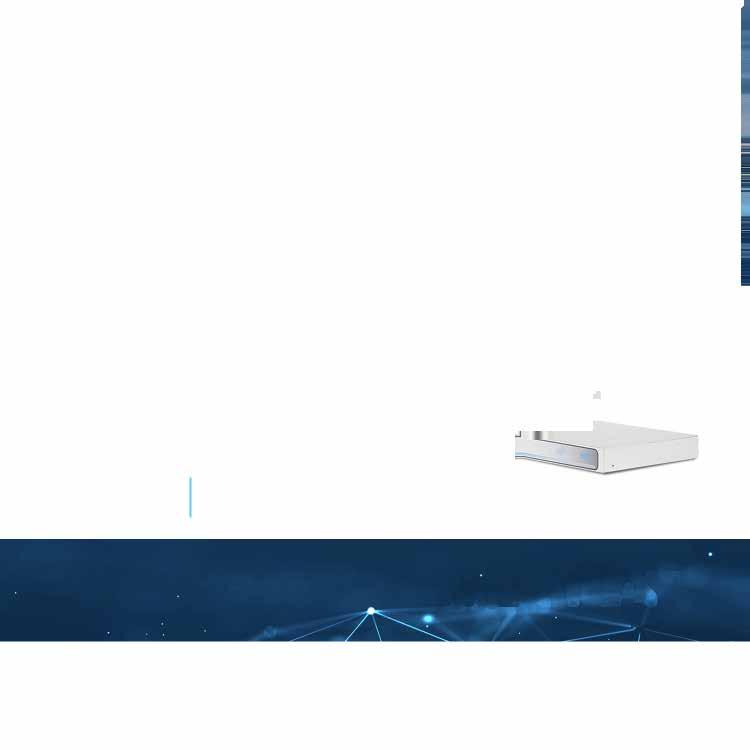
14 minute read
ATSC to Update Industry on 3.0 Progress
How a triad of organizations is making NextGen TV a reality
By Michael Silbergleid
There are three organizations that are proponents of ATSC 3.0 (or the more consumer-friendly NextGen TV), all approaching adoption of the non-mandatory standard differently: the ATSC (atsc.org), the NAB (nab.org) and Pearl TV (pearltv.com). All share a common goal: to make ATSC 3.0 the norm. A big part of that will be this year’s NAB Show.
Different Approaches
“The main goal for the ATSC is to provide the forum for the technical development to take place,” said Madeleine Noland, president of the Advanced Television Systems Committee. “As such, we’re the technical experts—the educators and vanguard for the technology. Our role is to make sure what ATSC 3.0 is and what it does, its benefits and to move the ball forward.”
ATSC members are continuing to develop the evolvable standard.
As the trade association for TV and radio broadcasters in the U.S., NAB represents broadcasters implementing advanced technologies like NextGen TV. “We help the industry be the best it can be,” said NAB CTO Sam Matheny. “For television, that’s through the adoption and implementation of ATSC 3.0.”
Then there’s Pearl TV, a consortium of more than 820 network-affiliated TV stations, with eight of the largest broadcast companies in the U.S. that is leading the NextGen TV transition. They’re the organization that said last December that by the end of 2023, NextGen TV services will reach 75% of the U.S. population.
“Pearl TV’s mission over the last 10 years has been to work collectively on investing in and fostering new technology platforms and services that would further the businesses of the industry,” said Anne Schelle, managing director for Pearl TV. “The biggest part of our efforts have been around developing the proper infrastructures to foster a robust marketplace for receiver manufacturers to build and sell a product to consumers, for consumers to know it exists and to be educated on the benefits of NextGen TV, and helping broadcasters to be able to stand up quality services.”

Pearl TV works on the collaboration mechanisms to transition markets and the agreements that need to be created. That has led to the creation of templates for the industry and managing transitions in the markets with the networks. They work with manufacturers and broadcasters on the promotional aspects of NextGen TV, providing on-air promos that they’ve produced. They also do market research with consumers with regard to what the expectations are in a next generation television.
“We have a NextGen TV FastTrack program with high-volume consumer manufacturers,” said Schelle. “Our lab in

Bradenton, Fla. helps to fix compliance issues that have cut nine months off the time to get products to market.”
Pearl TV is also responsible for making sure that each consumer device meets the required specifications in order to receive official NextGen TV licensing and certification logo use.
You might have noticed the switch between the terms used by each organization: The ATSC and the NAB using ATSC 3.0—the industry terminology, while Pearl TV uses NextGen TV—the more consumer and manufacturer marketing terminology.
Consumer Adoption
While it might appear that adoption is slow, that’s far from the truth. Since the beginning of the year, Miami and Boston have joined the ranks and by the time you read this, another market or country may have joined the ATSC 3.0 family as more than a dozen markets are poised to start services this year. In January, The Republic of Trinidad and Tobago adopted the ATSC 3.0 standard, joining the U.S., Jamaica, South Korea and certain ATSC 3.0 elements by Brazil.
In the same way that consumers want superior 4K content for their new 4K TVs, research has shown that when they see the benefits of ATSC 3.0 they want that too.
According to the NAB’s Matheny, his top three reasons for ATSC 3.0 are fairly simple: better pictures, better sound and interactivity.
But, it’s the consumer that really matters.
“When you describe what NextGen TV is in our ads (watchnextgentv.com) and show it to consumers, they score really high with 50% of consumers wanting to buy it,” said Pearl TV’s Schelle. “The value proposition is there with higher quality video for sports and free TV. Some rank audio the biggest benefit with dialog enhancement, movie theater sound and consistent volume across channels. Plus more high value content and interactivity over time with future upgradeability—those are selling points in and of itself.”

While many ATSC 3.0 broadcasters are currently spectrum constrained for 4K—as broadcasters must still provide an ATSC 1.0 signal (typically with one station handling ATSC 1.0 for themselves and another station, while the other handles ATSC 3.0 for both)— Schelle sees that as a future driver, with HD HDR as a selling point today.
Another driver for today is free OTA TV. A test by Pearl TV with an antenna placed in the middle of a house in Baltimore pulled approximately 160 channels from both the Baltimore and Washington, D.C. markets.
“Retailers are waiting for a national platform, until NextGen TV is readily available in most places or their places,” said Schelle.
That’s why ATSC 3.0 market rollouts appear to happen only in larger markets–they scale well for manufacturers, but those come with challenges, including negotiations between stations as to the logistics of who does what, as well as business concerns.
“The focus on larger markets tracks with the last transition,” said NAB’s Matheny. Smaller markets come later in the process. It’s in alignment with history. But there are lots of small markets planning to go on air in 130+ DMAs this year.
“Plus, smaller markets get to benefit from the larger markets going first and products to mature, so it’ll be a lot easier for them, especially with industry expertise from the ATSC, Pearl TV and us on how to deploy,” he added. “The NAB has also been advocating to the FCC to modify some of the restrictions on channel sharing so more stations can do this more easily.”
ATSC 3.0/NEXTGEN TV AT NAB SHOW
The triad of ASTC 3.0/NextGen TV supporting organizations plan a full court press for NAB Show.
Aside from the NAB celebrating its 100th anniversary, Matheny’s department is responsible for the Broadcast Engineering & IT Conference, which consists of almost 50 presentations and panels over four days with ATSC 3.0 adoption heavily featured. According to Matheny, these sessions will feature national security applications, video coding techniques, media workflow, broadcast facility design and much more.
The ATSC will be in the West Hall at W3443, showing new developments, hosting events for opportunities to highlight ATSC 3.0, showing the first NextGen TV licensed and logoed set-top boxes, and reminding attendees that as of January 2023, approximately 14,000 ATSC 3.0 TVs are sold daily.
The ATSC booth will also host Pearl TV, where Schelle will discuss FastTrack and consumer messaging to broadcasters deploying NextGen TV—along with all the ins and outs of sending out a quality signal, application services, having local news and weather, what consumers say about it and who is using it. l

Matthews Studio Equipment Gatorbuddy
Gatorbuddy is a professional tool to help video shooters and photographers work with bounce and fill cards in an efficient way to increase productivity. The sturdy yet mobile Gatorbuddy features a steel base and four Tente caster wheels. It can glide around the studio and then lock safely in place to enable lighting adjustments. Gatorbuddy can be used to move panels and V-Flats smoothly in and out to swap backgrounds.
In addition to creating walls and dividers instantly, Gatorbuddy also can be equipped with a laptop or monitor to use as a workstation. The design features a sturdy wheeled base with a low center of gravity for stability. Eight inserts offer positioning of the three screw-in aluminum Baby Risers while a slider knob accommodates width and angle adjustment of various size panels. A Junior Wall Plate can be added to support a C+Riser or V-Flat holder as well as adjust angles. z For more information, visit www.msegrip.com
Xytech Granite
Granite, a new version of Xytech’s Media Operations Platform for end-to-end media production, provides 400+ new and improved features with customizable feature sets. Granite gives Xytech customers the ability to take full advantage of the platform for managing people, equipment, resources, facilities, and logistics. With enhancements and additions to its APIs and integrations such as OpenID, Azure AD, MS Exchange, Google Calendar, MS SharePoint and many more, media production teams no longer need to switch programs while completing critical tasks, as Xytech enables them to work in a single platform to trigger workflows, saving time, and increasing productivity.
Long-Term Planning, the newest addition created for Granite, allows users to track, report and compare resource capacity and demand, providing companies with greater visibility into their media pipelines. z For more information, visit www.xytechsystems.com.
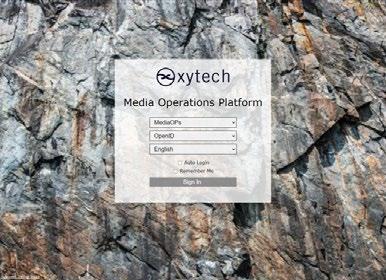
AWS Elemental Timecode Burn-in
AWS Elemental MediaLive now offers timecode burn-in so that users can add timecode visually into individual video outputs from a MediaLive channel. While visual timecode is not generally used when delivering video to viewers, this feature is useful for testing, monitoring, and compliance. MediaLive allows configuration on an individual output basis, so users can separate audience delivered outputs from outputs with burned-in timecode for technical monitoring. Timecode burn-in in MediaLive is available at no additional cost.
AWS Elemental MediaLive is a broadcast-grade live video processing service for creating high-quality live video streams for delivery to TVs and multiscreen devices. The MediaLive service functions independently or as part of AWS Media Services, a family of services that form the foundation of cloud-based workflows and offer you the capabilities you need to transport, create, package, monetize, and deliver video.
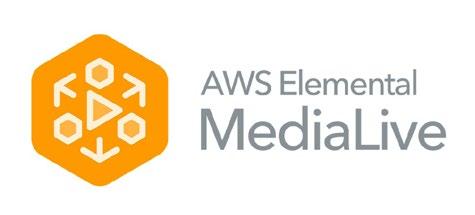
z For more information, www.aws.amazon.com/medialive.
Vegas Creative Software Vegas Pro 20 Update
Vegas Creative Software has released a free update for its Vegas Pro 20 that adds the ONNX Runtime AI engine to make better use of GPU power from a wider selection graphics cards. The update, now available for free to existing users and incorporated into the release for new users, enables faster processing of AI functions in the Vegas Pro workflow.
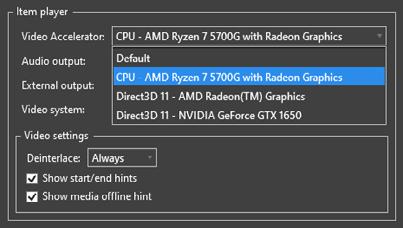
The release also offers new features such as additional advanced color curves, enabling editors to dial in with more precise control of their color workflows. The update includes other new workflow features and enhancements to improve efficiency and collaboration directly on the timeline. Vegas Pro 20 is available as three options: Vegas Edit, Vegas Pro; and Vegas Post.
z For more information, visit www.vegascreativesoftware.com.
Studio Technologies Model 545DC and Model 545DR Intercom Interfaces
Studio Technologies’s Model 545DC and Model 545DR intercom interfaces allow users to use analog party-line (PL) intercom circuits with contemporary Dante audio-over-Ethernet (AoE) applications.

Model 545DC, designed for use with single-channel analog partyline (PL) intercom circuits, supports two single-channel PL intercom circuits and is directly compatible with single-channel analog partyline (PL) products from Clear-Com. Model 545DR, intended for use in applications such as broadcast, provides two-channels of analog PL on a single 3-conductor cable, It also offers one 2-channel interface and works directly with the RTS TW-series of 2-channel analog intercom circuits. Both can interconnect with Dante-supported devices, including Studio Technologies’ line of Dante-enabled user beltpack, intercom station and intercom audio engine products. z For more information, visit www.studio-tech.com.
Cinegy Cinegy Air v22.12
Cinegy Air v22.12 is a major upgrade to the current version. The new version, part of Cinegy’s rolling development program, also includes an update to the graphics and branding engine, now called Cinegy Title.
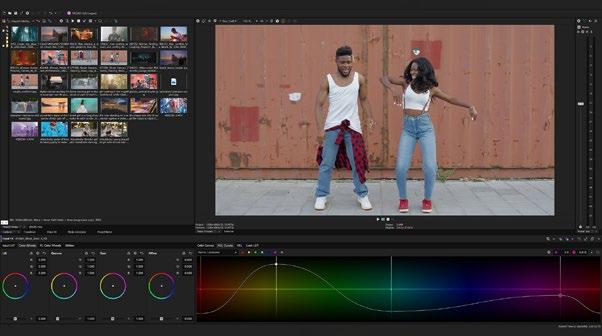
Cinegy Air can now play out both HDR and SDR sources through an HLG Air engine, with the ability to select conversion LUTs per item. LUTs are applied automatically where possible, and can be manually selected from dropdown options within the playlist tab. The playout engine can now also create a simulcast SDR stream from a primary HDR engine. Cinegy Air can now also generate Kantar audio watermarks for audience measurement and content protection.
Other new functionality includes enhanced preview playout for playlist verification. For multichannel operators Air Playlist Editor can now use audio matrix and character generator settings across multiple playlists, ensuring consistency across regional variations, for example. Cinegy Air now also supports the Rosstalk Protocol, to seamlessly control routers and other hardware from within the playlist. z For more information, visit www.cinegy.com
Avid Media Composer 2022-12

Avid has unveiled v2022-12 of Media Composer with several new features that significantly speed up post production between editorial and audio post teams and produce significant production efficiency by bringing video and audio post teams and workflows closer together. One key development is closer integration with Pro Tools—with the upgrade, Media Composer sequences can be directly exported into Pro Tools with video, audio and metadata combined into one export .PTX file that can be opened directly in Pro Tools.
The new version also offers full support for Avid’s completely reimagined MBOX Studio audio interface, providing editors with a powerful solution for recording, punch-ins and multichannel monitoring of sequences in up to 7.1 surround sound. Access to the preamps and audio converters in MBOX Studio also enables users to capture every sonic nuance of every performance with low-latency monitoring. z For more information, visit www.avid.com/media-composer
Irdeto ActiveCloak for Media
Irdeto has launched a new and improved ActiveCloak for Media (ACM), a software digital rights management software development kit. The enhanced solution includes multiple layers of security designed to ensure content encryption keys cannot be illegally extracted from devices.
Many devices in use today lack hardware DRM protection and rely solely on its operating system software DRM, making them highly vulnerable to content key extraction. With content encryption keys in hand, pirates can create a host of problems, including the delivery of illegal services leading to missed revenue opportunities and increased CDN cost.
ACM helps to avoid the reputational and operational impact by protecting the video applications themselves instead of relying on the device’s operating system DRM to secure the content on vulnerable devices. With Irdeto ACM, the content decryption will bypass the device’s operating system software DRM, taking place inside the video application itself instead.
z For more information, visit www.irdeto.com
Magewell Pro Convert Audio DX
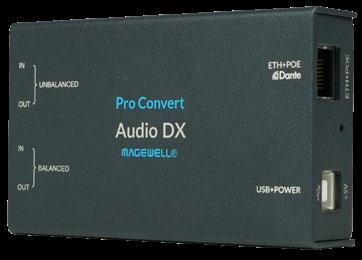
The Pro Convert Audio DX multi-format IP audio encoder, decoder and capture device is Magewell’s first to offer integrated support for Audinate Dante audio networking, enabling users to convert audio between Dante, NDI and SRT transport technologies while also bridging analog audio, software and IP networks.
Pro Convert Audio DX can send and receive up to eight channels of audio in unicast or multicast Dante flows (audio streams). In addition to Dante, the device also supports uncompressed audio using the NDI media-over-IP technology or compressed AAC audio using the lowlatency SRT protocol.
With the ability to convert between Dante, NDI and SRT, the new device enables mixed-technology local and remote production workflows that combine best-of-breed products supporting different standards and formats. The Pro Convert Audio DX also can serve as a gateway to the IP domain for analog audio, encoding signals into Dante, NDI or SRT streams. Similarly, it can decode IP audio streams for analog output. z For more information, visit www.magewell.com
Newtek Flex Control Panel
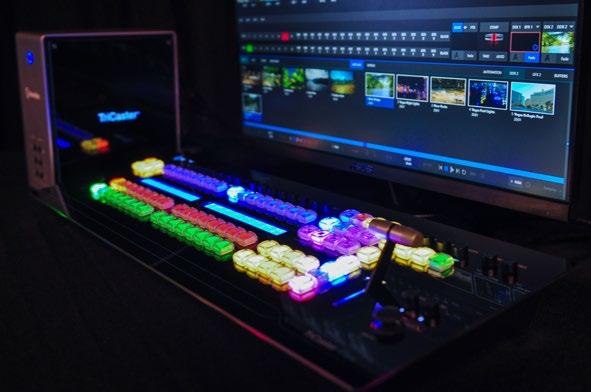
Newtek’s new Flex control panel enables operators to control PTZ cameras directly, as well as audio connections, audio and video switching and talkback via NDI. This is the first NewTek control panel to build in control over audio and video switching and PTZ control and talkback in a single unit.
The built-in features offer operators greater precision and control. With the addition of audio I/O, Flex expands the on-board I/O of any NewTek TriCaster with the option to add external sources directly from the NDI ecosystem. Flex connects to a network via NDI, making unnecessary the physical tether to the video switcher with fixed cable runs and complex setups that are difficult to move to a new location. The new control panel not only can connect to any TriCaster switcher on a network via NDI, but it also supports operators needing to work in a distributed production environment.
z For more information, visit www.newtek.com
Enensys Technologies ModulCast-ATSC

Enenysys Technologies has introduced ModulCast-ATSC, its new ATSC 3.0 OEM modulator for integration into digital TV transmitters. ModulCast-ATSC is an optimized and unique modulator board supporting the ATSC 3.0 standard. It meets with the requirements of transmitter manufacturers for rapid and straightforward integration and delivers high-performance RF output to meet broadcasters’ quality requirements.
Focused on SFN low-power transmitter applications, ModulCastATSC is designed to offer high-quality RF performance combined with digital power amplifier precorrection. It is fully compliant with FCC standards without any channel filter, simplifying operation and reducing costs for LPTV stations.
z For more information, visit www.enensys.com
Canon Add-On Application System for PTZ Remote Cameras
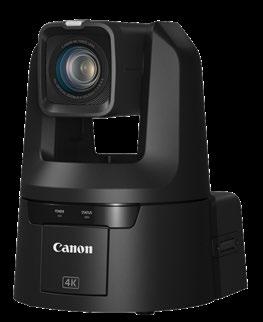
A new firmware update for Canon’s pan-tilt-zoom (PTZX) remote cameras now provides access to new paid video production features. Applications on the “Add-On Application System” include auto tracking and auto loop functions for Canon’s CRN700 4K PTZ camera. The auto tracking application enables the CRN700 to pan, tilt and zoom automatically as it tracks moving subjects. The auto loop application allows users to program and automate repeated camera movements.
The Add-on Application System can be added with a future firmware update. Canon plans to expand the number of applications it offers as well as the lineup of compatible remote camera models. As opposed to competitive offerings that require an external control device, the new paid add-on applications run directly from within the Canon PTZ camera. The auto tracking add-on reduces the workload of the camera operator, allowing users to focus on other tasks, such as switching and streaming. It also allows for multiple cameras on set to shoot with fewer people. z For more information, visit www.usa.canon.com
Playbox Technology OTT Stream Content Management System Ad Server
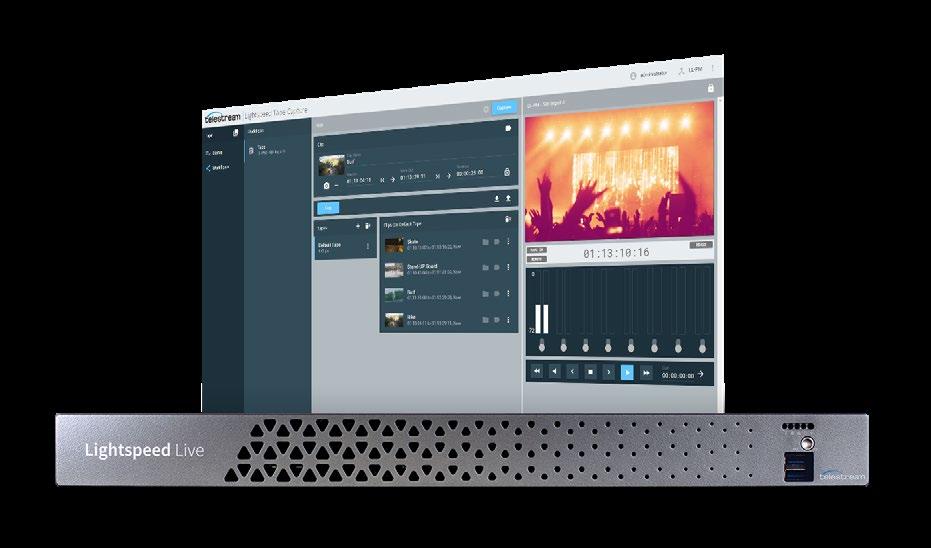
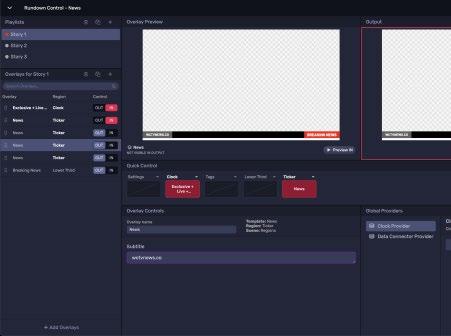
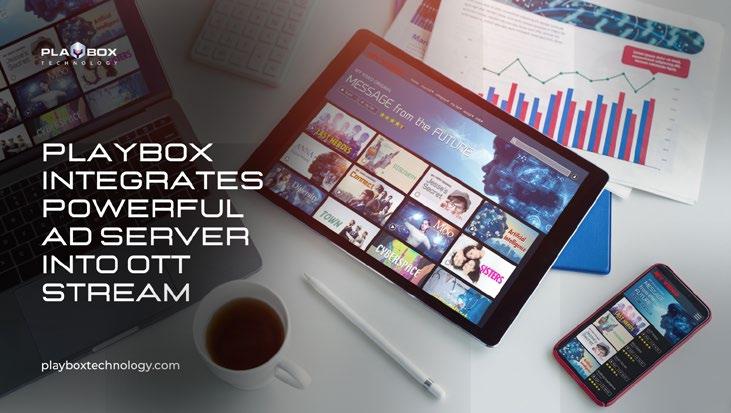
Playbox Technology has enhanced its OTT Stream Content Management System with a fully integrated, automated ad server. Whether the stream is an alternate delivery platform for broadcasters or a new service from a content owner, the addition of the ad server can maximize potential ad revenue by enabling precise ad placement in streams.

The OTT Stream cloud solution offers playout capabilities for multiple channels and services. Available as a perpetual license or as a softwareas-a-service, it takes advantage of the scalability and flexibility of the cloud to allow users to grow functionality and offerings as subscriber demand blossoms. With the ad server capability, media companies can manage and monetize streaming content more effectively and efficiently. The ad server can insert and manage ad content in live and on-demand streams and it also offers media companies a way to analyze and optimize ad placement.
z For more information, visit www.playboxtechnology.com
Telestream Lightspeed Live Capture v3.5
Version 3.5 of Telestream’s Lightspeed Live Capture multichannel on-premise ingest solution allows broadcasters to connect the software over IP networks locally or remotely using SMPTE 2110 with NMOS, NDI sources and SRT sources. The new capability augments existing Transport Stream and RTMP IP format support. The new connectivity methods provide reliable, low-latency, frame-accurate connections over common IP network implementations while preserving source synchronization.
NMOS support for SMPTE ST 2110 adds a control plane that makes the infrastructure simpler to operate. The implementation comes with full support for the ISO4 and ISO5 specifications. Using the ISO4 specifications within NMOS, Lightspeed Live Capture can query for information about other devices.
The software also registers its capabilities and discovers other devices where live capture workflows might originate. ISO5 is used by Lightspeed Live Capture to perform the setup and removal of media flows between itself and the sending device.
For more information visit

Flowics Updated Control Interface for HTML-5 Graphics Solution
Flowics has unveiled an updated control interface for Flowics Graphics, its HTML5based broadcast graphics solution. New control interface features include: updated Rundown Control, which gives graphics operators the freedom to sort, rename, duplicate and create multiple instances of overlays based on graphics templates without loading all existing overlays; options to change text, image or data provider when duplicating an overlay. It also provides the ability to create playlists over overlays, making it possible to meet all operational scenarios during show production. The more efficient workflow available to teams working in a cloud-native environment make it possible for users to collaborate remotely without needing local installation, hardware or virtual machines.
For more information visit www.flowics.com










